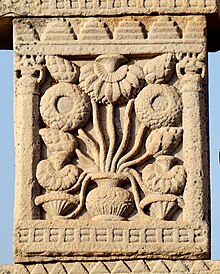
A kalasha, also called Pūrṇa-Kalaśa, Pūrṇa-Kumbha, Pūrṇa-Ghaṭa, also called ghat or ghot or kumbh (Sanskrit: कलश kalaśa, Telugu: కలశము Kannada: ಕಳಶ literally "pitcher, pot"), is a metal (brass, copper, silver or gold) pot with a large base and small mouth. It is employed in the rituals in Hindu, Jain, and Buddhist traditions as a ceremonial offering to the deity or to an honoured guest and as an auspicious symbol used to decorate shrines and buildings.[2]
Sometimes "kalasha" also refers to such a pot filled with water and topped with a coronet of mango leaves and a coconut. This combination is often used in Hindu rites and depicted in Hindu iconography. The entire arrangement is called Purna-Kalasha (पूर्णकलश), Purna-Kumbha (पूर्णकुम्भ), or Purna-ghata (पूर्णघट). Each of these names literally means "full or complete vessel" when the pot is referred to as the Kalasha (to avoid confusion, this article will refer to the pot as Kalasha and the entire arrangement as Purna-Kalasha).
Sometimes the Kalasha is filled with coins, grain, gems, gold, or a combination of these items instead of water. The coronet of 5, 7, or 11 mango leaves is placed such that the tips of the leaves touch water in the Kalasha. The coconut is sometimes wrapped with a red cloth and red thread; the top of the coconut (called Shira – literally "head") is kept uncovered. A sacred thread is tied around the metal pot. The Shira is kept facing the sky.
The Kalasha is viewed as an auspicious object in Jainism. The Kalasha is used as a ceremonial object as well as a decorative motif in Indian art and architecture. The Kalasha motif was used in decorating bases and capitals of pillars during 1st century BCE and 1st century CE.[3][4] Before their depiction on stone, terracotta kalash were used as decorative feature placed on roof-tops of buildings and it is now mostly used on temples roofs called Mandir Kalasha.[5]
- ^ Cologne Digital Sanskrit Dictionaries: Monier-Williams Sanskrit-English Dictionary Padmotpalakumudvat (पद्मोत्पलकुमुद्वत्):— [=padmotpala-kumud-vat] [from padma] mfn. furnished with the lotus flowers called Padma, Utpala and Kumuda, [Bhāgavata-purāṇa]
- ^ Aryan, K. C. (1981). Basis of Decorative Element in Indian Art. Rekha Prakashan. p. 93. ISBN 978-81-900002-8-4.
- ^ Aryan, K. C. (1981). Basis of Decorative Element in Indian Art. Rekha Prakashan. p. 93. ISBN 978-81-900002-8-4.
- ^ Students' Britannica India by Dale Hoiberg, p. 183 Published 2000, Popular Prakashan, ISBN 0-85229-760-2
- ^ Uesugi, Akinori; Oya, Hiroshi; Peter, Jenee (2020). "Roof Tiles in Ancient South Asia: Its Developments and Significance". Center for Cultural Resource Studies, Kanazawa University, Kakuma-machi, Kanazawa, Ishikawa.